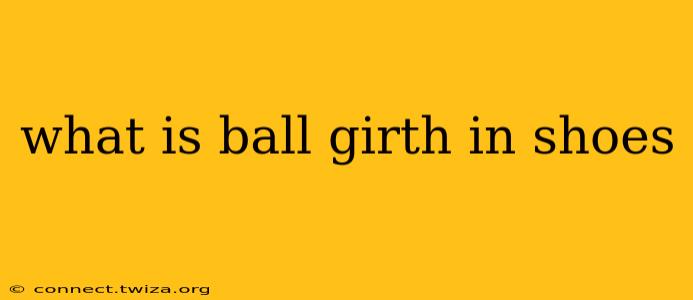Finding the perfect pair of shoes often involves more than just knowing your shoe size. Understanding key measurements, like ball girth, is crucial for achieving optimal comfort and preventing foot problems. This comprehensive guide will explain ball girth in shoes, its importance, and how it relates to finding the ideal fit.
What exactly is ball girth?
Ball girth refers to the widest part of your foot, typically located just behind your toes. It's a crucial measurement in shoe fitting because a shoe that's too narrow in the ball area can cause discomfort, bunions, blisters, and other foot problems. Unlike the length of your foot (which determines your shoe size), ball girth addresses the width. Manufacturers use this measurement to create shoes in various widths, such as narrow, medium, wide, and extra-wide.
Why is ball girth important for shoe fit?
Proper ball girth is paramount for comfort and foot health. A shoe that's too tight in the ball area can compress your toes, restrict blood flow, and lead to:
- Blisters: Friction and pressure from a too-tight shoe create blisters on the toes and the ball of the foot.
- Bunions: Consistent pressure on the big toe joint can lead to the development of bunions, painful bony bumps.
- Hammertoes: Tight shoes can force toes into unnatural positions, causing hammertoes (bent toes).
- Metatarsalgia: Pain in the ball of the foot, often caused by pressure and inflammation of the metatarsal bones.
- Ingrown toenails: Constricted toe space can increase the risk of ingrown toenails.
How do I find my ball girth?
While shoe stores sometimes offer ball girth measurements, it's often not a standard practice. The best way to determine your ball girth is by using a Brannock device, a specialized measuring tool commonly used in shoe stores. This device measures both the length and width of your foot, providing a more precise fit. Alternatively, you can measure your foot at home using a ruler and a piece of paper, but this method is less precise. Focus on measuring the widest part of your foot, ensuring the measuring tape is snug but not overly tight.
How does ball girth relate to shoe size?
Shoe size refers to the length of your foot, while width (often indicated by letters like B, M, W, WW) reflects your ball girth. You can have a standard length (size) but require a wider or narrower width depending on your foot's shape. It's crucial to consider both length and width for a proper fit. Many manufacturers offer shoes in various widths, so finding a shoe that accommodates your ball girth is essential.
What if I have a high ball girth?
If you have a high ball girth (wide foot), don't despair! Many brands offer wide-width shoes, and some specialize in accommodating wider feet. Look for shoes specifically labeled as "wide," "extra-wide," or those that mention accommodating wider feet in their descriptions. Consider trying on several brands to find one that provides the best fit. Online retailers often include width specifications in their product descriptions, aiding your search.
What if my shoes are too tight in the ball area?
If you're experiencing discomfort in the ball of your foot, don't ignore it! Continue wearing shoes that are too tight in the ball area can lead to long-term foot problems. Consider purchasing shoes with a wider fit, using shoe stretchers to gently widen the shoe, or consulting a podiatrist for advice.
By understanding ball girth and its importance in shoe fitting, you can significantly improve your comfort and protect your foot health. Prioritizing proper fit is an investment in your long-term well-being.
